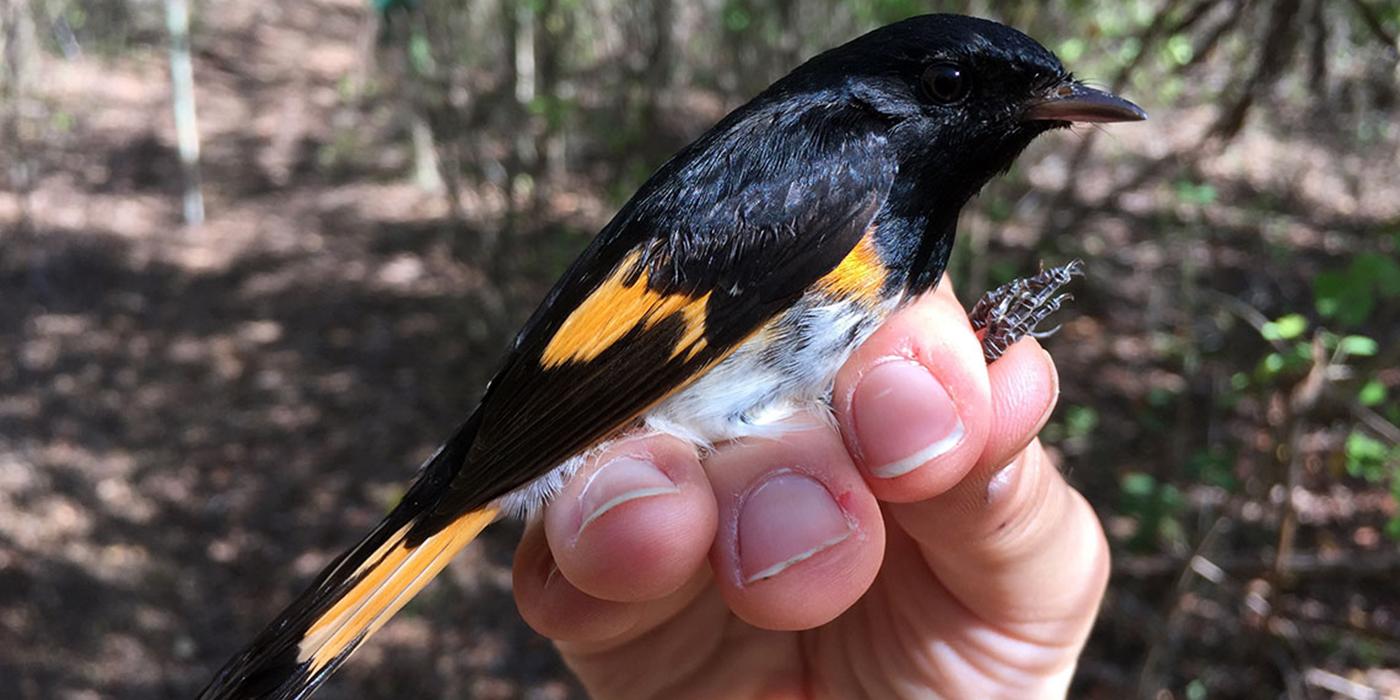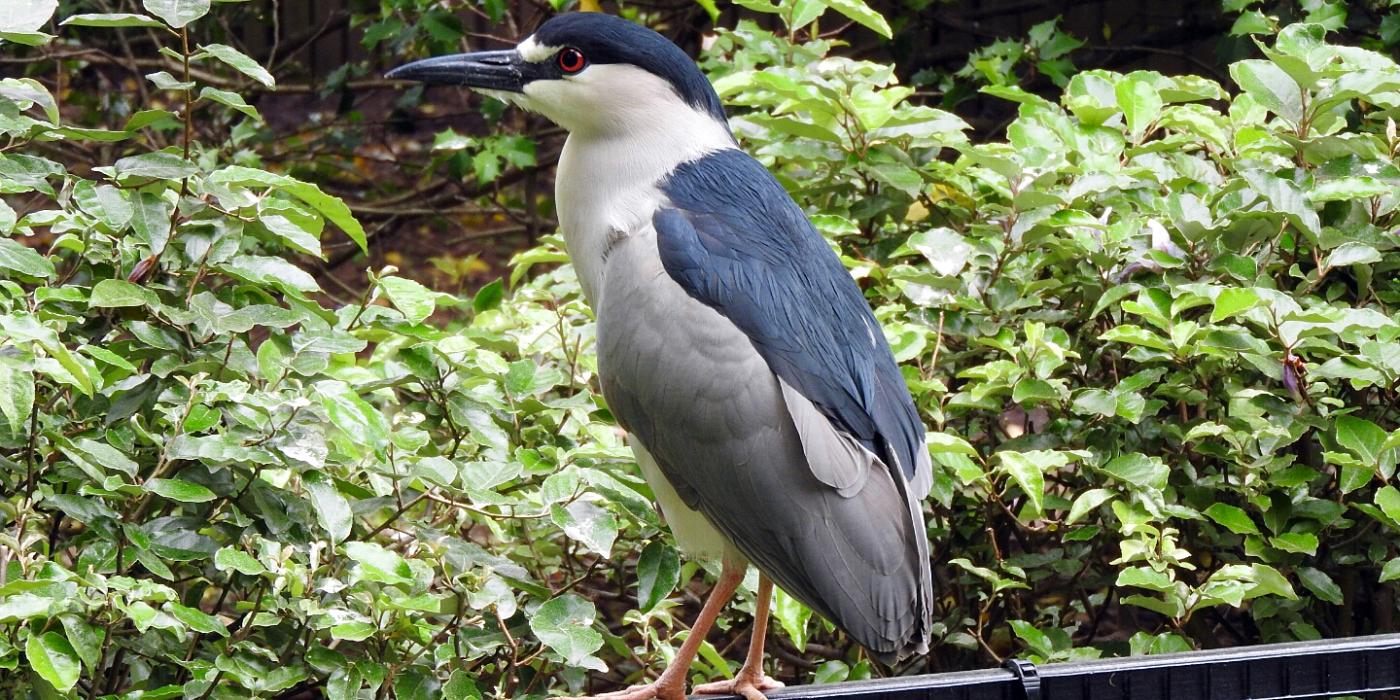The Christmas Bird
American Redstart
The Turkey Vultures could be seen circling overhead from miles away and the smell was so strong it made your eyes tear. Pulling into the dump in Negril, Jamaica wasn't my idea of a fun way to spend a morning doing bird research in the West Indies, but it turned out to be a easy way to observe December's Bird of the Month, the American Redstart (Setophaga ruticilla).
Although this species is known by some in the tropics as the "latrine bird" because of its tendency to forage around outhouses and garbage dumps searching for flies, I would rather refer to it by its other local name, the "Christmas bird." This more flattering name was probably coined because of the brilliant, almost ornamental, black and orange plumage of the adult male and the fact that this species is commonly seen during the Christmas months in tropical regions.
Redstarts actually spend the majority of the year in the tropics. In September, they begin arriving on their wintering grounds, which extend from southern Mexico and the Caribbean to northeastern South America. Upon arrival, they immediately begin establishing territories with the use of several aggressive behaviors including vocalizations, aerial displays, and posturing.
Disputes along territorial boundaries often lead to both males and females exhibiting a behavior known as "circling." This behavior involves one redstart making a rapid and deliberate flight toward another perched redstart. The two birds then change perches and the chase is repeated, sometimes with one bird consistently being the aggressor and at other times the two birds continuously circling toward the other with no obvious dominant aggressor.
Behaviors such as this can persist for several hours, especially during territory establishment in autumn. Some individuals, especially older males are more aggressive and will win most of these battles with neighbors. These differences in aggressive behavior are thought to be responsible for a pattern of habitat occupancy known as sexual habitat segregation, in which some habitats have a higher proportion of males and others a higher proportion of females.
Redstarts remain on these territories until about mid-April, when they begin their migration back to their breeding grounds in the United States and Canada. In New Hampshire, at the Hubbard Brook Experimental Forest in the White Mountains, where I have been studying redstarts for the past nine years, adult males begin arriving around the 10th of May, but the arrival period will typically stretch out for another month as young males and females return later in early June.
Almost immediately after arriving, a female will select a male with which to breed and begin searching for suitable nest sites within that male's territory. Nest sites are located at the crotch of a branch leaving the main trunk of a tree. Nests are placed at varying heights, anywhere from one meter to 15 meters above the ground. Females construct a nest composed predominately of strands of yellow birch bark with a lining of animal hair, rootlets or lichens. After nest completion, females will lay an average of 3 to 4 eggs, which they begin incubating when the second to last egg is laid.
Unlike many species of migratory birds which raise 2 successive sets of young, i.e., broods, during a single breeding season, redstarts call it quits after successfully raising a single brood. However, if the first nesting attempt fails, for example, if a predator eats the eggs or young, redstarts will continue trying to raise a successful brood, as long as environmental conditions remain favorable.
Male redstarts can be polygynous and polyterritorial. That is to say, males can sometimes be paired with two females, but rather than having both females on the same territory they maintain two separate and disjunct territories. You might be wondering how one male can balance two females and two nests at once, especially considering that both parents feed the young. Well, the trick lies in the fact that the nests are not entirely synchronous. Males typically do not start advertising for a second female until the first and primary female has started incubating. That way if the male is successful in attracting a second female, he minimizes the overlap of parental care duties between the two nests and can fledge significantly more young.
Adult male redstarts are black as coal with bright orange patches on their side, wings, and tail, while the females the females are a dull gray-olive with yellow patches on their sides, wings and tail. While there is a clear distinction between adult males and females, juvenile males, for some unknown reason, look like adult females until after their first breeding season (that is, until the second fall after they hatch). This phenomenon is called "delayed plumage maturation" and it occurs in 35 species of migratory songbirds. Considerable debate has occurred among scientists trying to figure out why this pattern persists, but to date no one has offered a satisfactory explanation.
At the end of the breeding season in late June and July, redstarts disperse from their breeding areas. We really don't know where they go at this point although it is thought that they move into river valleys and slowly migrate south en route to their wintering grounds.
During this time, redstarts undergo a complete molt of their body and flight feathers. Young males that spent the previous breeding season looking like females molt into the black and orange plumage of an adult male, while females and older males retain the same color and plumage patterns of the previous year.
In September and October, redstarts arrive once again onto their wintering quarters and the territorial battles commence to decide which piece of land they will occupy until returning to the breeding grounds.
One thing that is still not known is precisely where birds that breed in any particular location in the United States or Canada spend the winter, or vice versa. I just hope that the redstarts we study in the pristine forests of the White Mountains in New Hampshire know better than to spend their entire winter foraging on flies from the chicken bones and juice containers of the Negril Dump!


